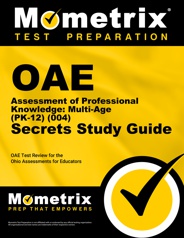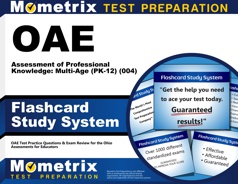The Ohio Assessment for Educators (OAE) Assessment of Professional Knowledge Multi-Age (PK–12) exam is designed for all candidates seeking to become a licensed educator in the state of Ohio.
Click “Start Test” above to take a free OAE Assessment of Professional Knowledge practice test, and check out our premium-quality OAE test prep resources by clicking the links below!
Exam Outline
The Assessment of Professional Knowledge exam contains 100 multiple-choice questions and two written assignments, and you will be given a time limit of 3 hours.
The exam is split into three domains:
I. Student Development and Learning (24%)
The questions in this domain assess your knowledge and skills in the following areas:
- Processes of human development
- Variations in student development
- Learning processes
- Factors that can impact student learning and performance
- Student diversity
- Providing learning opportunities and environments that are responsive to student differences, promote student learning, and foster appreciation of and respect for diversity
II. Assessment, Instruction, and the Learning environment (50%)
The questions in this domain assess your knowledge and skills in the following areas:
- Assessment instruments and practices
- The relationship between instruction and assessment
- Procedures and principles of instructional and curricular planning
- Using effective planning to design instruction that promotes learning and achievement
- Practices and principles associated with carious instructional approaches
- Practices and principles of motivation and communication
- Structuring and managing the classroom to establish an inclusive, safe, and positive environment that is productive and organized
III. The Professional Environment (26%)
The questions in this domain assess your knowledge and skills in the following areas:
- Establishing partnerships and collaborating effectively with families, colleagues, and the community
- Roles and expectations for professional educators
- Ethical and legal guidelines
- Strategies for continuous professional growth and self-reflection
Check Out Mometrix's OAE Study Guide
Get practice questions, video tutorials, and detailed study lessons
Get Your Study Guide
Exam Registration
When you are ready to register for the exam, you will need to create an account with the Pearson Vue testing center. At this point, you will select which testing method you want to use: in-person or remote.
Regardless of the testing method, the cost of the exam is $109.
Test Day
In-person Testing
On the day of your exam appointment, you should arrive at the Pearson VUE testing center about 30 minutes earlier than the scheduled exam time. After you arrive, you will be asked to sign in and present your photo ID to the proctor. You will be photographed and asked to sign a roster and other rule forms.
Personal items such as your cell phone, wallet, keys, and accessories are not allowed in the testing room, so they should be left at home or placed in a secure locker outside the testing area.
Just before the exam starts, you will be given a brief tutorial on the testing system and will be asked to sign an NDA.
Remote Testing
Before the day of the exam, you should ensure your equipment meets the minimum requirements. You must have a desktop or laptop with a webcam and microphone, and you should take your exam in a private workspace. The exam cannot be taken on mobile devices, smartphones, or tablets. The technical requirements can be detailed on Pearson’s website.
On the day of your exam, you will be asked to show the remote proctor your testing space and submit a valid form of photo ID. The proctor will walk you through the examination process after the check-in process is complete.
How the Exam is Scored
Your OAE score is determined by the State Board of Education of Ohio using a scale-based scoring system. This system involves taking your raw score, which is the number of correct answers you provided, and converting it to a numerical score on a scale of 100 to 300. The minimum passing score is 220.
You will receive your score report before leaving the testing center for in-person testers, while remote test-takers will receive their report within 2 weeks after testing.
Check Out Mometrix's OAE Flashcards
Get complex subjects broken down into easily understandable concepts
Get Your Flashcards
FAQs
Q
How many questions are on the Assessment of Professional Knowledge: Multi-Age (PK–12) exam?
A
There are 102 questions on the exam.
Q
How long is the Assessment of Professional Knowledge: Multi-Age (PK–12) exam?
A
The time limit for this exam is 3 hours.
Q
What is the passing score for the Assessment of Professional Knowledge: Multi-Age (PK–12) exam?
A
To pass this exam, you must achieve a minimum scaled score of 220.
Q
How much does the Assessment of Professional Knowledge: Multi-Age (PK–12) exam cost?
A
The examination fee is $109.
